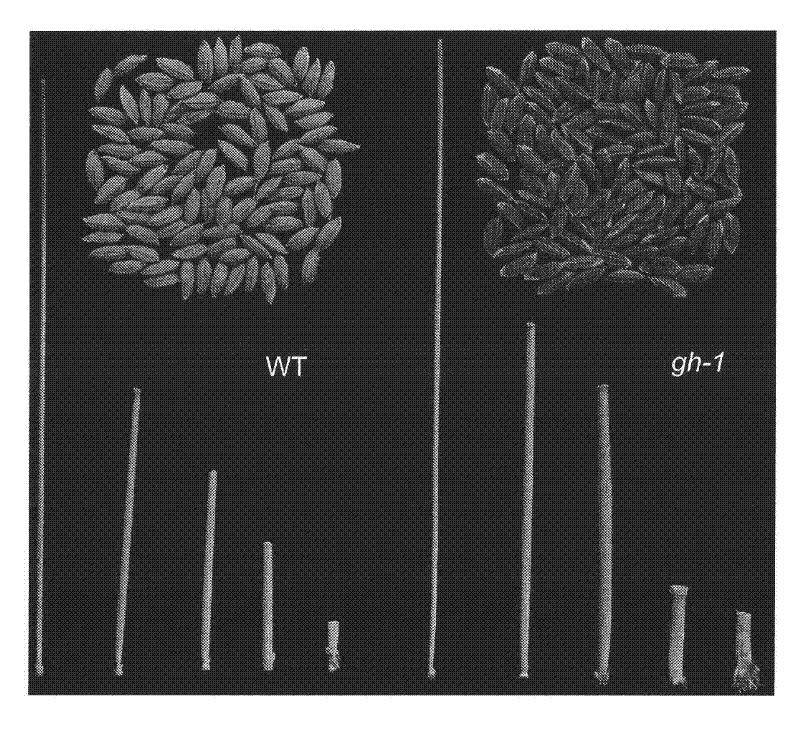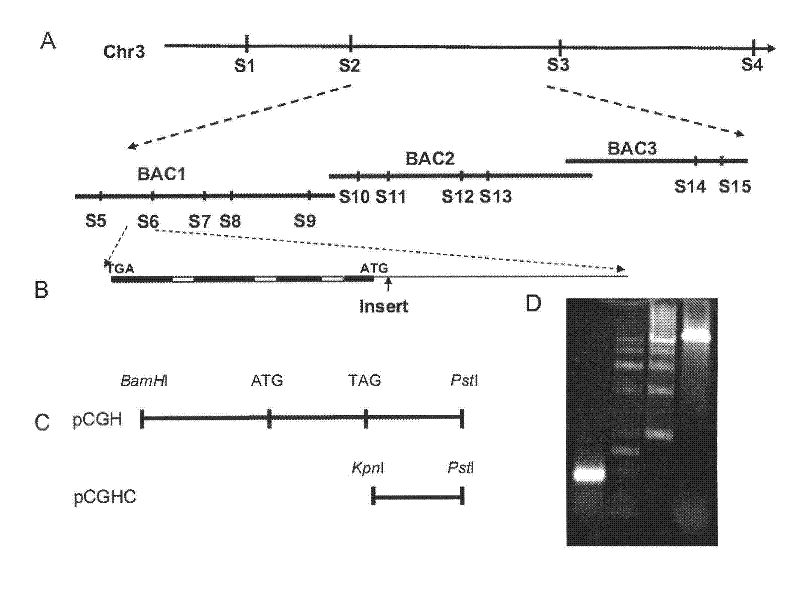Protein used for controlling anthocyanidin content, coding gene thereof, and application thereof
A technology that encodes genes and proteins, and is applied in the direction of using vectors to introduce foreign genetic material, cells modified by introducing foreign genetic material, and plant peptides. Enhance the body's antioxidant capacity and high economic benefits
- Summary
- Abstract
- Description
- Claims
- Application Information
AI Technical Summary
Problems solved by technology
Method used
Image
Examples
Embodiment 1
[0047] Example 1, the acquisition of protein GH-1 and its coding gene for controlling anthocyanin content
[0048] 1. Phenotype analysis of rice golden glume mutant gh-1
[0049] The rice golden glume mutant gh-1 (International Rice Research Institute, Gramene Accession: GR: 0060365) is a near allele of ZF802 (WT) (preserved by the National Rice Data Center of China Rice Research Institute, registration number GS01003-1989) gene line. Compared with the control ZF802, the phenotype of the golden glume was brown-red from the heading stage, and the husk and stalks were brown-red when mature ( figure 1 ). The mutant phenotype does not affect the normal growth and development of rice under normal cultivation conditions. figure 1 The upper middle left is the seed of the control ZF802, which is light yellow; the upper right is the panicle of the golden glume mutant gh-1, which is reddish brown; the lower left is the stem of the control ZF802, which is light yellow; the lower rig...
Embodiment 2
[0071] Embodiment 2, Complementation experiment of gh-1 phenotype of golden glume mutant
[0072] 1. Construction of complementary vector pCGH and complementary control vector pCGHC
[0073] BAC OsJNBa0017N05 (purchased from Shanghai National Gene Research Center, Chinese Academy of Sciences, No. OsJNBa0017N05) was digested with PstI and BamHI to obtain 3005 bases upstream of the start codon ATG and 3360 bases after the stop codon TGA of GH-1 The DNA fragment (7996bp) of the full-length sequence of bases was cloned between the PstI and BamHI recognition sites of pCAMBIA1300 (DingGuo, MCV033), and the complementary expression vector pCGH was constructed. The constructed complementary vector pCGH was digested with KpnI, the promoter region, exon and part of the 3' end sequence of the GH-1 gene were removed, and part of the regulatory region at the 3' end was retained, and the complementary control vector pCGHC was constructed ( image 3 Middle C).
[0074] 2. Obtaining and phe...
Embodiment 3
[0076] Embodiment 3, the overexpression verification test of GH-1 gene
[0077] 1. Construction of overexpression vector pGHOX
[0078] According to the method of step 5 in Example 1, the ORF of GH-1 was obtained, and the vector was digested with Sal I and Xba I to obtain a fragment of about 700bp, and then this fragment was connected to Sal I and Xba I of the overexpression vector pCam13OX for recognition Between the sites, the overexpression vector pGHOX was constructed.
[0079] The construction method of pCam130X is as follows:
[0080] Using the primer pair 35S-F: (5'-AAGCTTCCCAGATTAGCCTTTTCAAT-3') and 35S-R: (5'-CTGCAGTCCCCCGTGTTTCTCTCAA-3') PCR amplified plasmid pBI121 (DingGuo, MCV032) to obtain a constitutive CaMV35S promoter fragment of about 850bp , the fragment was double digested with Pst I and Hind III and then ligated into the Pst I and Hind III recognition sites of the vector pCAMBIA1300 (DingGuo, MCV033) to form the intermediate vector pCam13OXM. Plasmid pB...
PUM
 Login to View More
Login to View More Abstract
Description
Claims
Application Information
 Login to View More
Login to View More - R&D
- Intellectual Property
- Life Sciences
- Materials
- Tech Scout
- Unparalleled Data Quality
- Higher Quality Content
- 60% Fewer Hallucinations
Browse by: Latest US Patents, China's latest patents, Technical Efficacy Thesaurus, Application Domain, Technology Topic, Popular Technical Reports.
© 2025 PatSnap. All rights reserved.Legal|Privacy policy|Modern Slavery Act Transparency Statement|Sitemap|About US| Contact US: help@patsnap.com



